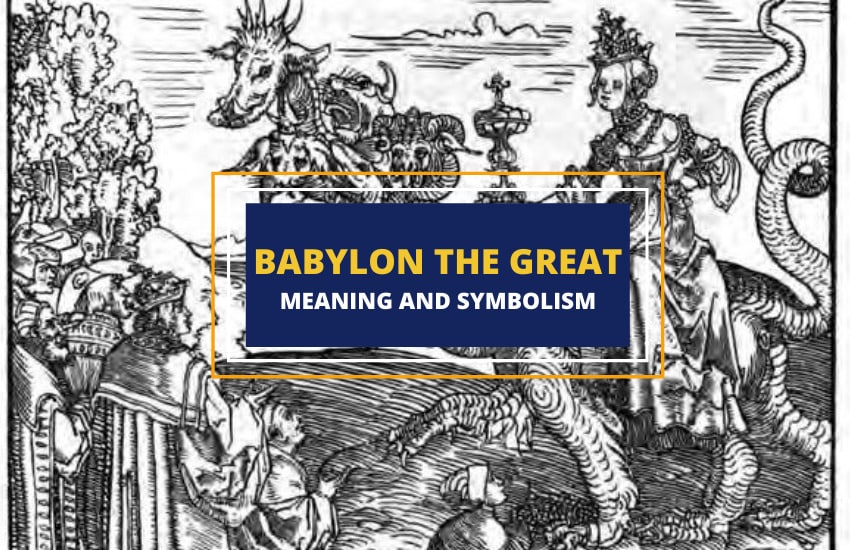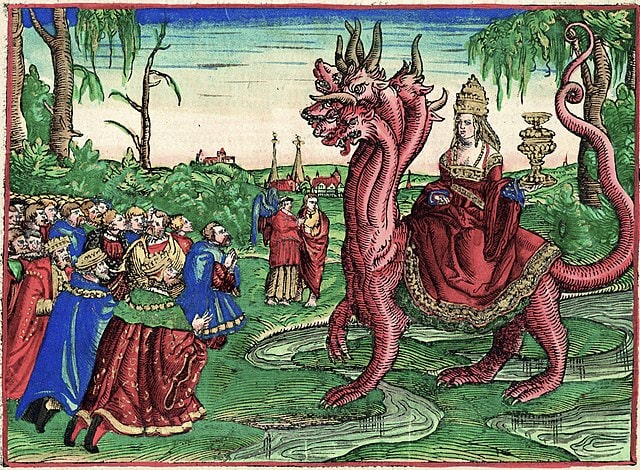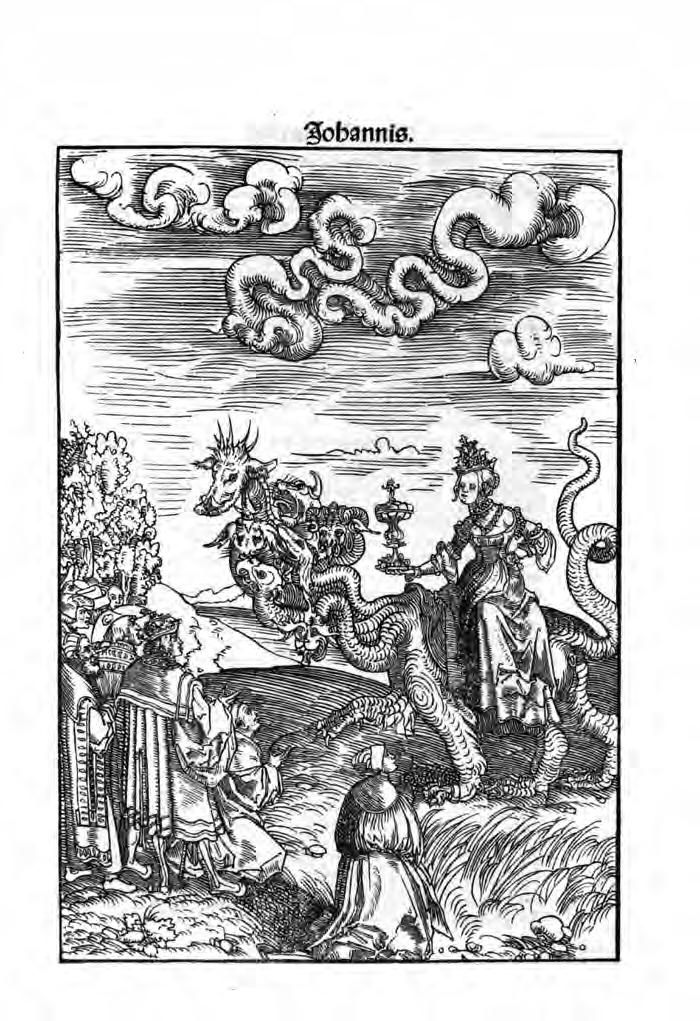
Table of Contents
“Come, I will show you the punishment of the great prostitute, who sits by many waters.” (Revelation 17:1).
The Whore of Babylon (also called Babylon the Great) is one of the most enigmatic figures in Christian eschatology, prominently featured in the Book of Revelation.
The first mention of Babylon the Great can be found in the Book of Revelation in the Bible. Largely symbolic, Babylon the Great, also known as the Whore of Babylon, refers to both an evil place and a whorish woman.
As a symbol, Babylon the Great represents anything that is tyrannical, evil, and treachery. She represents the end of times and is affiliated with the Antichrist. She is mysterious, and her origins and meaning are still debated.
How did Babylon become the archetype for treachery, tyrannical authority and evil? The answer is found in the long history of Israel and Western Christianity.

Hebrew Context of Babylon the Great
The Hebrew people had an adversarial relationship with the Babylonian empire. In the year 597 BCE, the first of several sieges against Jerusalem resulted in the king of Judah becoming a vassal of Nebuchadnezzer. After this, a series of revolts, sieges, and deportations of the Hebrew people came in subsequent decades. The story of Daniel is an example of this.
This led to the period of Jewish history known as the Babylonian captivity. The city of Jerusalem was razed and the Solomonic temple destroyed.
The impact this had upon the Jewish collective conscience can be seen throughout the Hebrew scriptures in books such as Isaiah, Jeremiah, and Lamentations.
The Jewish narrative against Babylon includes the origin myth of the Tower of Babel in Genesis 11 and the calling of Abraham by God out from his home in Ur of the Chaldeans, a people identified with the region of Babylon.
Isaiah chapter 47 is a prophecy of the destruction of Babylon. In it Babylon is depicted as a young woman of royalty “without a throne” who must sit in the dust, enduring shame and humiliation. This motif carries over into the New Testament description of Babylon the Great.
Early Christian Symbolism
There are only a few references to Babylon in the New Testament. Most of these are genealogical accounts at the beginning of the Gospel of Matthew. The two references to Babylon which apply to Babylon the Great or the Whore of Babylon occur much later in the New Testament canon. Both harken back to the description of Babylon as an archetype for rebellion in the Hebrew Bible.
St. Peter makes a brief reference to Babylon in his first letter – “She who is at Babylon, who is likewise chosen, sends you greetings” (1Peter 5:13). What is interesting about this reference is that Peter was nowhere near the city or region of Babylon. Historical evidence places Peter at this time in the city of Rome.
The ‘she’ is a reference to the church, the group of Christians gathered with him. Peter is making use of the Jewish conception of Babylon and applying it to the greatest city and empire of his day, Rome.
The specific references to Babylon the Great occur in the Book of Revelations written by John the Elder toward the end of the 1st Century CE. These references are found in Revelation 14:8, 17:5 and 18:2. The full description is found in chapter 17.
In this description, Babylon is an adulterous woman who sits upon a great, seven-headed beast. She is clothed in royal garments and jewels and has a name written upon her forehead – Babylon the Great, Mother of Harlots and Of Earth’s Abominations. She is said to be drunk from the blood of saints and martyrs. From this reference comes the title ‘Whore of Babylon’.
Who is the Whore of Babylon?

This brings us to the question:
Who is this woman?
Throughout the centuries there have been no shortage of potential answers given. The first two views are grounded in historical events and places.
1. The Roman Empire as the Whore of Babylon
Perhaps the earliest and most common answer has been to identify Babylon with the Roman empire. This comes from several clues and combines the description in John’s Revelations with Peter’s reference.
Then there is the explanation of the great beast. The angel speaking to John tells him that the seven heads are seven hills, a possible reference to the seven hills upon which the city of Rome is said to be founded.
Archeologists have uncovered a coin minted by the emperor Vespasian around 70 CE which includes a depiction of Rome as a woman sitting on seven hills. One of the first church historians, Eusebius, writing in the early 4th century, supports the view that Peter was referring to Rome.
If Rome is the Whore of Babylon, this would not simply be because of its political power, but because of its religious and cultural influence which drew people away from the worship of the Christian God and following Jesus Christ.
It also has a great deal to do with the brutality of the Roman government toward early Christians. By the end of the 1st century, several waves of persecution would have befallen the early church due to decrees of emperors and local government officials. Rome had drunk the blood of martyrs.
2. Jerusalem as the Whore of Babylon
Another geographical understanding for the Whore of Babylon is the city of Jerusalem. The description found in Revelation depicts Babylon as an unfaithful queen who has committed fornication with kings from foreign lands.
This would draw upon another motif found in the Old Testament (Isaiah 1:21, Jeremiah 2:20, Ezekiel 16) in which Jerusalem, representative of the people of Israel, is described as a harlot in her unfaithfulness to God.
The references in Revelation 14 and 18 to Babylon’s “fall” are references to the destruction of the city in 70 CE. Historically Jerusalem was also said to be built upon seven hills. This view of Babylon the great is making specific reference to the Jewish leaders’ rejection of Jesus as the promised Messiah.
With the fall of the Roman empire and the subsequent ascension of the Roman Catholic church, Medieval European ideas on the topic changed. The most prevalent of views grew from St. Augustine’s seminal work known as City of God.
In this work, he depicts all of creation as a great battle between two opposing cities, Jerusalem and Babylon. Jerusalem represents God, his people, and the forces of good. They battle against Babylon which represents Satan, his demons, and people in rebellion against God.
This view was dominant throughout the Middle Ages.
3. The Catholic Church as the Whore of Babylon
During the period of the Reformation, writers such as Martin Luther outlined that the Whore of Babylon was the Catholic Church.
Drawing upon the depiction of the church as “Bride of Christ,” early reformers looked upon the corruption of the Catholic Church and viewed it as unfaithful, committing adultery with the world to gain wealth and power.
Martin Luther, who began the Protestant Reformation, wrote a treatise in 1520 entitled On the Babylonian Captivity of the Church. He was not alone in applying the Old Testament depictions of God’s people as unfaithful harlots to Popes and church leaders. It did not go unnoticed that the see of papal authority was in the very city founded upon the seven hills. Multiple renditions of the Whore of Babylon from this time show her clearly wearing the papal tiara.
Dante Alighieri includes Pope Boniface VIII in the Inferno equating him with the Whore of Babylon because of the practice of simony, the selling of church offices, which was rampant under his leadership.
4. Other Interpretations
In modern times, the number of theories identifying the Whore of Babylon have continued to increase. Many drawing upon ideas from previous centuries.
The view that the Whore is synonymous with the Catholic Church has continued to linger, though it is waning in recent years as ecumenical efforts have increased. A more common view is to attribute the title to the “apostate” church. This could refer to any number of things depending on what constitutes apostasy. This view is often associated with groups who have broken away from more traditional Christian denominations.
A more mainstream view today is to see the Whore of Babylon as a spirit or a force. It may be cultural, political, spiritual, or philosophical, but it is found in anything that is opposed to Christian teaching.
Finally, there are some who look at current events and apply the title Whore of Babylon to political entities. That might be America, multi-national geo-political powers, or secret groups who control the world from behind the scenes.
The Political Dimension of The Whore of Babylon
The Whore of Babylon wasn’t just a religious symbol; it was a potent political instrument. Aligning opponents with the Whore was an effective strategy to consolidate support and rally the masses against perceived enemies. Martin Luther’s association of the Papal establishment with Babylon served a dual purpose: a theological critique and a political challenge to the overpowering influence of the Vatican. This interplay between theology and politics underscores the multifaceted applications of religious symbolism, proving its utility far beyond spiritual contexts.
In Brief
Understanding Babylon the Great cannot be divorced from the experience of the ancient Hebrew people. It also cannot be understood apart from the experiences of invasion, foreign rule and persecution felt by numerous groups throughout the centuries.
The Whore of Babylon, as with many symbols in Revelation, is rich with layers of meaning. Her identity has evolved over time, reflecting changing religious, historical, and cultural contexts. Whether viewed as a historical city, a representation of corrupt religious systems, or a future entity, ultimately the Whore serves as a potent reminder of the challenges believers face and the hope that prevails.








